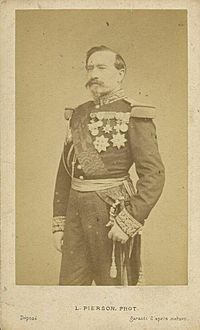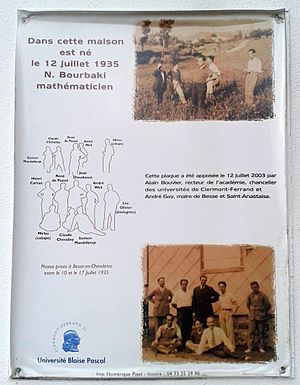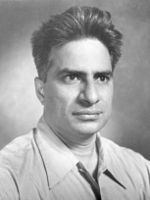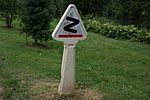Nicolas Bourbaki facts for kids
|
Association des collaborateurs de Nicolas Bourbaki
|
|

Bourbaki congress at Dieulefit in 1938. From left, Simone Weil, Charles Pisot, André Weil, Jean Dieudonné (sitting), Claude Chabauty, Charles Ehresmann, and Jean Delsarte.
|
|
| Named after | Charles-Denis Bourbaki |
|---|---|
| Formation | 10 December 1934 (first unofficial meeting) 10–17 July 1935 (first official, founding conference) |
| Founders |
|
| Founded at | Latin Quarter, Paris, France (first unofficial meeting) Besse-en-Chandesse, France (first official, founding conference) |
| Type | Voluntary association |
| Purpose | Publication of textbooks in pure mathematics |
| Headquarters | École Normale Supérieure, Paris |
|
Membership
|
Confidential |
|
Official language
|
French |
|
Formerly called
|
Committee for the Treatise on Analysis |
Nicolas Bourbaki is the made-up name (a pseudonym) for a group of mathematicians. Most of them were French and studied at a famous school called the École Normale Supérieure (ENS).
The group started in 1934–1935. Their first idea was to write a new textbook about analysis, which is a part of mathematics. But their project grew much bigger! They ended up publishing a huge series of textbooks under the name Bourbaki. These books were meant to cover all of modern pure mathematics.
This big series of books is called the Éléments de mathématique (Elements of Mathematics). It's the group's most important work. The books cover many topics like set theory (how to group things), abstract algebra (math with symbols), topology (shapes and spaces), analysis, and Lie groups (special math groups).
The Bourbaki group was formed because of the First World War. Many young French mathematicians died in the war, leaving old textbooks in use. While teaching, Henri Cartan and André Weil felt the teaching materials were not good enough. Weil suggested they meet with other mathematicians in Paris to write a modern analysis textbook together.
The main founders were Cartan, Claude Chevalley, Jean Delsarte, Jean Dieudonné, and Weil. Other people joined for a short time, and the group's members have changed over the years. Former members can talk about their time with the group, but current members keep their involvement a secret.
The name "Bourbaki" comes from a French general from the 1800s, Charles-Denis Bourbaki. He was famous for his military wins but also for a big loss in a war. So, the name was well-known to French students. André Weil remembered a student joke at ENS where someone pretended to be a professor and taught a "theorem of Bourbaki." The group later decided to use this name.
The Bourbaki group holds regular private meetings to write and improve the Éléments books. They divide topics among smaller teams. Drafts are discussed, and everyone must agree before a text can be published. This process is slow and takes a lot of work. But it makes sure the books are very accurate and general. The group also runs the Séminaire Bourbaki, which is a series of math talks. These talks are given by group members and others, and they are also published. The Bourbaki group has an office at the ENS.
Nicolas Bourbaki was very important in 20th-century mathematics, especially in the middle of the century when many Éléments books came out. The group is known for its strict way of presenting math and for introducing the idea of a mathematical structure. This idea is similar to a bigger concept called structuralism used in other fields. Bourbaki's work even influenced the "New Math" trend in elementary school math in the 1960s.
The group is still active today, but its influence has gone down because new Éléments volumes are published less often. Their most recent book came out in 2019, about spectral theory. Another book on the same topic is expected in 2023.
Contents
The Bourbaki Name and History
Charles-Denis Sauter Bourbaki was born in France in 1816. He became a successful general under Napoleon III, fighting in wars like the Crimean War. However, during the Franco-Prussian War, General Bourbaki suffered a major defeat. He was tricked into going to Britain for a fake peace meeting. When he returned, he was given a task to help lift a siege, but he failed. Charles-Denis Bourbaki and his army had to retreat into Switzerland, where they were disarmed. He died in 1897, and the story of his defeat became well-known in France.
World War I's Impact on Math
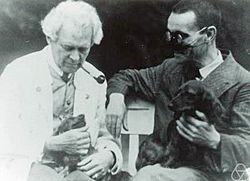
The First World War deeply affected everyone in Europe, including mathematicians and students. Many young men who would have become mathematicians fought and died. For example, the French mathematician Gaston Julia, known for his work on fractals, lost his nose in the war. He had to wear a leather strap over his face for the rest of his life.
Many students from the ENS, a top math school, died in the war. This created a "lost generation" in French mathematics. Some estimates say that a quarter to half of French math students died. André Weil, a Bourbaki founder, noted that France sent its young scientists to the front lines. Germany, however, tried to protect its young students and scientists.
How the Name Was Chosen
In the 1920s, a new group of math students, including André Weil, attended ENS. Weil remembered a student prank where an older student pretended to be a professor. He gave a math lecture and ended it by saying, "Theorem of Bourbaki: you are to prove the following..."
Weil also knew about another prank where a student claimed to be from a poor country called "Poldevia" and asked for donations. Later, when Weil was teaching in India, he suggested to a mathematician named Damodar Dharmananda Kosambi to write an article and credit it to "D. Bourbaki." This was a joke to show off Kosambi's knowledge. Kosambi did it, saying the material was from "the little-known Russian mathematician D. Bourbaki, who was poisoned during the Revolution." This was the first time "Bourbaki" appeared in math writing.
The Bourbaki Group's Work
Starting the Group
While teaching in Strasbourg, André Weil and Henri Cartan often complained about the old textbooks for calculus. Weil had an idea in late 1934. He told Cartan, "We are five or six friends... Let's all get together and sort out these problems once and for all." This moment, Weil said, was when Bourbaki was born.
The first unofficial meeting happened on December 10, 1934, at a café in Paris. Six mathematicians were there: Henri Cartan, Claude Chevalley, Jean Delsarte, Jean Dieudonné, René de Possel, and André Weil. They decided to write a math book on analysis together. Their goal was to make calculus teaching better in French universities. They especially wanted to replace an old textbook by Édouard Goursat. They also wanted to include new ideas from famous mathematicians like David Hilbert and Emmy Noether.
Jean Delsarte thought working together would protect their work from individual copyright claims. He also suggested starting the book with the most basic, abstract math ideas. The group agreed, calling this part the "Abstract Packet." They first called themselves the Committee for the Treatise on Analysis.
They held ten meetings before their first official conference in July 1935. During this time, Paul Dubreil, Jean Leray, and Szolem Mandelbrojt joined. Dubreil and Leray later left and were replaced by Jean Coulomb and Charles Ehresmann.
The group's official founding conference was in Besse-en-Chandesse from July 10 to 17, 1935. The members decided to rename the group "Bourbaki." To make their made-up name seem real, they wanted to publish an article under "his" name. René de Possel's wife, Eveline, gave the pseudonym the first name "Nicolas." So, Nicolas Bourbaki was "born." Henri Cartan's father, Élie Cartan, a mathematician himself, helped them publish their first article under "Bourbaki's" name.
World War II and Beyond
Bourbaki's work slowed down during the Second World War. Some members, like André Weil and Laurent Schwartz, were Jewish and had to flee from certain areas to avoid the Nazis. Weil ended up in the United States. He stayed in touch with the group but was less involved after the war.
After the war, Bourbaki became very productive. They published many volumes of the Éléments in the 1950s and 1960s, which was their most influential period. The founding members slowly left the group, and younger mathematicians joined, like Jean-Pierre Serre and Alexander Grothendieck. Several Bourbaki members, including Serre, Grothendieck, and Schwartz, won the Fields Medal, a top award in mathematics.
Later, the group had a disagreement. Grothendieck wanted to rewrite the books using category theory as the main idea, instead of set theory. But the group had already published many books based on set theory and didn't want to start over. Grothendieck left the group because of this.
Bourbaki had some legal issues with their publisher in the 1970s, which slowed them down. For a while, they published new books very rarely. In 1998, a newspaper even said the group was "dead." However, in the 2010s, Bourbaki started publishing more Éléments books again.
How Bourbaki Works
Bourbaki holds regular meetings to expand the Éléments. These meetings are the main part of their work. Small teams write drafts, which are then discussed and rewritten at the conferences. Everyone must agree before anything can be published. A single part of the book might go through six or more drafts over several years. This process is very slow, but it ensures the final book is extremely precise.
The group wanted their books to be very strict and formal, unlike some older math texts that focused more on ideas than on detailed proofs. In the early years, Jean Dieudonné wrote many of the final drafts. He used a special, impersonal writing style that suited the whole group.
Most of Bourbaki's Éléments books avoid pictures, using only text and formulas. One exception was the section on Lie groups and Lie algebras, which included diagrams. This was because of Armand Borel, a Swiss member, who felt that visual learning was important. When asked why there were so few pictures, former member Pierre Cartier joked that the group was like "Puritans" who didn't like pictures of truths.
The conferences are usually held in quiet, rural places. But the discussions can be very lively and even heated. Laurent Schwartz remembered a time when Weil slapped Cartan on the head with a draft! The hotel owner thought the group would break up, but peace was restored quickly. Weil believed that new ideas often come from strong discussions. Dieudonné was also known for loudly threatening to quit if anyone suggested a different order for certain topics in the books.
Despite these arguments, Bourbaki did well in the mid-20th century. It's surprising that a group with such strong debates could produce so much work. Henri Cartan called it "a kind of miracle." It's thought that the group survived because its members believed strongly in their shared project. When they overcame a difficulty or liked an idea, they would say l'esprit a soufflé ("the spirit breathes"). This "spirit" was part of their internal culture and helped them work together.
Humor in the Group
Humor has always been important to the group, starting with Weil's memories of student pranks. In 1939, the group even put out a fake wedding announcement for "Betti Bourbaki" (Nicolas's daughter) to "H. Pétard," a "lion hunter." This was full of math jokes. Their internal newsletter, La Tribu (The Tribe), often has funny subtitles for their conferences, like "The Extraordinary Congress of Old Fogies" (where anyone over 30 was an "old fogy").
In the 1940s and 1950s, the American Mathematical Society received applications for membership from "Bourbaki." They were told that only individuals or institutions could join, not a collective. In response, Bourbaki spread a rumor that a mathematician named Ralph Boas wasn't a real person but a made-up name for a group of editors! This was because Boas had described Bourbaki as a collective in an encyclopedia. In 1968, a fake obituary for Nicolas Bourbaki was even released during one of their seminars.
The group also made up special words. "Bourbaki" could mean the group or a single member, like "André Weil was a Bourbaki." To "bourbakize" meant to take a bad text and make it better through editing. This humor helped the group stay together and deal with the stress of their intense debates. Today, there's even a Twitter account for "Betty_Bourbaki" that shares updates on the group.
Bourbaki's Publications
Bourbaki's work includes their main textbook series, a series of lecture notes, journal articles, and an internal newsletter.
The Éléments de mathématique Series
The Éléments books are divided into "books" (major topics), "volumes" (physical books), and "chapters." They also include summaries and historical notes. The publication history is complex, with revisions, out-of-order releases, and different groupings. For example, the "Algebra" book was first released in eight French volumes. Later, it was condensed into five volumes.
When the group started, they planned a "treatise on analysis." The first part was supposed to cover the basic ideas of math needed for analysis, called the "Abstract Packet." But this "opening section" grew so big that it became several volumes, covering set theory, abstract algebra, and topology. Because the project became much larger than planned, they changed the title to Éléments de mathématique. The unusual singular "Mathematic" showed Bourbaki's belief that all of mathematics is connected.
The first six "books" of the Éléments are numbered and ordered logically. They build on each other, meaning you learn one concept before the next. This first half is called Les structures fondamentales de l’analyse (Fundamental Structures of Analysis). It covers well-known math topics in Bourbaki's style. The second half covers newer research areas and doesn't depend on each other in the same strict way.
Some volumes were just summaries of results without proofs. These were called Fascicules de résultats. The first Éléments volume published was a summary of results in Theory of Sets in 1939.
After publishing less often in the 1980s and 1990s, Bourbaki increased its output in the 2010s. They released a rewritten chapter on algebra in 2012, new chapters on Algebraic Topology in 2016, and revised chapters on Spectral Theory in 2019. More chapters on spectral theory are expected in 2023.
| Year | Book | References |
|---|---|---|
| 1954 | Theory of Sets | |
| 1942 | Algebra | |
| 1940 | General Topology | |
| 1949 | Functions of a Real Variable | |
| 1953 | Topological Vector Spaces | |
| 1952 | Integration | |
| 1960 | Lie Groups and Lie Algebras | |
| 1961 | Commutative Algebra | |
| 1967 | Spectral Theory | |
| 1967 | Differential and Analytic Manifolds | |
| 2016 | Algebraic Topology | |
| 1960 | Elements of the History of Mathematics |
Séminaire Bourbaki
The Séminaire Bourbaki is a series of math lectures that has been held regularly since 1948. Both members and non-members of the group give these talks. As of today, there have been over a thousand recorded lectures, covering about 10,000 pages of printed material.
Articles and Newsletter
Several math articles have been published under the name Bourbaki. Unlike the Éléments, these were usually written by individual members, not the whole group. Jean Dieudonné's essay "The Architecture of Mathematics" is seen as Bourbaki's "manifesto." In it, Dieudonné talked about how math is connected and how "mathematical structures" can be used in different areas. He said the axiomatic method (starting with basic rules) helps solve problems efficiently.
La Tribu (The Tribe) is Bourbaki's private newsletter for current and former members. It usually describes recent conferences in a funny, informal way, sometimes with poetry. This humor and private language helped the group stay together and form its identity.
Who Are the Members?
As of 2000, Bourbaki has had "about forty" members in total. Usually, there are about ten to twelve active members at any time. The group keeps its current members secret. This is to make sure their work is seen as a group effort, not tied to any single person. It also helps them avoid unwanted attention. However, former members often talk about their time with the group after they leave.
New members are invited to conferences as "guinea pigs" to see if they fit in. If everyone agrees, they become full members. There's a rule that active members are supposed to retire around age 50. This rule was meant to ensure that younger mathematicians, who are often thought to do their best work when young, would always be in charge. This rule led to a complete change of members by 1958. However, some historians say this rule wasn't always strictly followed.
Among full members, everyone is equal. There's no official leader, and anyone can interrupt a meeting or challenge an idea. But André Weil was seen as "first among equals" in the early days. The group also liked to joke about older members getting more respect.
Bourbaki conferences are also attended by family, friends, and other mathematicians. The group has never had any female members.

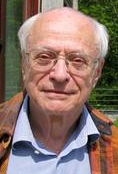
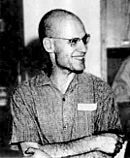
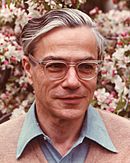
| Generation | Name | Born | ENS | Joined | Left | Died | |
|---|---|---|---|---|---|---|---|
| First | Core members | Henri Cartan | 1904 | 1923 | 1934 | c. 1956–58 | 2008 |
| Claude Chevalley | 1909 | 1926 | 1934 | c. 1956–58 | 1984 | ||
| Jean Delsarte | 1903 | 1922 | 1934 | c. 1956–58 | 1968 | ||
| Jean Dieudonné | 1906 | 1924 | 1934 | c. 1956–58 | 1992 | ||
| André Weil | 1906 | 1922 | 1934 | c. 1956–58 | 1998 | ||
| Minor members | Jean Coulomb | 1904 | 1923 | 1935 | 1937 | 1999 | |
| Paul Dubreil | 1904 | 1923 | 1935 | 1935 | 1994 | ||
| Charles Ehresmann | 1905 | 1924 | 1935 | 1950 | 1979 | ||
| Jean Leray | 1906 | 1926 | 1935 | 1935 | 1998 | ||
| Szolem Mandelbrojt | 1899 | — | 1935 | — | 1983 | ||
| René de Possel | 1905 | 1923 | 1934 | — | 1974 | ||
| Second | Jacques Dixmier | 1924 | 1942 | — | — | — | |
| Samuel Eilenberg | 1913 | — | c. 1951 | 1966 | 1998 | ||
| Roger Godement | 1921 | 1940 | — | — | 2016 | ||
| Jean-Louis Koszul | 1921 | 1940 | — | — | 2018 | ||
| Pierre Samuel | 1921 | 1940 | 1947 | 1971 | 2009 | ||
| Laurent Schwartz | 1916 | 1934 | — | — | 2002 | ||
| Jean-Pierre Serre | 1926 | 1945 | — | — | — | ||
| Third | Armand Borel | 1923 | — | c. 1953 | 1973 | 2003 | |
| François Bruhat | 1929 | 1948 | — | — | 2007 | ||
| Pierre Cartier | 1932 | 1950 | 1955 | 1983 | — | ||
| Alexander Grothendieck | 1928 | 1945 | 1955 | 1960 | 2014 | ||
| Serge Lang | 1927 | — | — | — | 2005 | ||
| John Tate | 1925 | — | — | — | 2019 | ||
| Later members | Hyman Bass | 1932 | — | — | — | — | |
| Arnaud Beauville | 1947 | 1966 | — | 1997 | — | ||
| Gérard Ben Arous | 1957 | 1977 | — | — | — | ||
| Daniel Bennequin | 1952 | 1972 | — | — | — | ||
| Claude Chabauty | 1910 | 1929 | — | — | 1990 | ||
| Alain Connes | 1947 | 1966 | — | — | — | ||
| Michel Demazure | 1937 | 1955 | — | c. 1985 | — | ||
| Adrien Douady | 1935 | 1954 | — | — | 2006 | ||
| Patrick Gérard[fr] | 1961 | 1981 | — | — | — | ||
| Guy Henniart | 1953 | 1973 | — | — | — | ||
| Luc Illusie | 1940 | 1959 | — | — | — | ||
| Pierre Julg | 1959 | 1977 | — | — | — | ||
| Gilles Lebeau | 1954 | 1974 | — | — | — | ||
| André Martineau | 1930 | 1949 | — | — | 1972 | ||
| Olivier Mathieu | 1960 | 1980 | 1989 | c. 2010 | — | ||
| Louis Boutet de Monvel | 1941 | 1960 | 1971 | 1991 | 2014 | ||
| Joseph Oesterlé | 1954 | 1973 | — | — | — | ||
| Charles Pisot | 1909 | 1929 | — | — | 1984 | ||
| Michel Raynaud | 1938 | 1958 | — | — | 2018 | ||
| Marc Rosso | 1962 | 1982 | — | — | — | ||
| Georges Skandalis | 1955 | 1975 | — | — | — | ||
| Bernard Teissier | 1945 | — | — | — | — | ||
| Jean-Louis Verdier | 1937 | 1955 | — | — | 1989 | ||
| Jean-Christophe Yoccoz | 1957 | 1975 | c. 1995 | c. 1995 | 2016 | ||
Bourbaki's Impact and Feedback
Bourbaki had a big impact on 20th-century mathematics. It also influenced other fields like anthropology and psychology, especially through the idea of structuralism. The group has been both praised and criticized for its way of presenting math, its working style, and the topics it chose.
Bourbaki's Influence
Bourbaki introduced several math symbols and words that are still used today. For example, Weil used the letter "Ø" (from the Norwegian alphabet) to mean the empty set (a set with no items). This symbol first appeared in their Theory of Sets book. They also introduced the words injective, surjective, and bijective to describe different types of functions.
They used simple words for some geometric shapes, calling them pavés (paving stones) and boules (balls). They also created the "dangerous bend" symbol (☡) in the margins of their books. This symbol warns readers that a part of the material is especially difficult. Bourbaki was most influential in the 1950s and 1960s, when their Éléments books were published often.
Bourbaki also influenced other subjects. In 1943, André Weil met the anthropologist Claude Lévi-Strauss. Weil wrote a math appendix for Lévi-Strauss's book, using group theory to describe marriage rules in some Australian Aboriginal societies. In 1952, Jean Dieudonné and Jean Piaget, a famous psychologist, discussed how math structures were similar to how children think. They were both impressed by the similarities.
Bourbaki's ideas were also mentioned by philosophers. Some philosophers used Bourbaki's strict, logical approach to math as an example in their own discussions about how knowledge is created.
The group also had a small influence on the arts. The literary group Oulipo, which creates experimental literature using math-based rules, was founded in a similar way to Bourbaki. Some Oulipo members were mathematicians.
In 2018, the music duo Twenty One Pilots released an album called Trench. The album's story included a city ruled by nine "bishops," one of whom was named "Nico" (short for Nicolas Bourbaki). This led to more people searching for "Nicolas Bourbaki" online!
Praise for Bourbaki
Many mathematicians have praised Bourbaki's work. Emil Artin, a mathematician, called the Éléments a "monumental work." He said it clearly showed how different parts of math are connected.
Bourbaki's books on Lie Groups and Lie Algebras are considered excellent and are often used as a standard reference. This success is partly because leading experts on the topic were Bourbaki members when those books were written. Jean-Pierre Bourguignon also praised the Séminaire Bourbaki lectures and the "superb and very clever proofs" in the Éléments.
Criticism of Bourbaki
Bourbaki has also faced criticism from mathematicians, including some former members. People have criticized their choice of topics, their presentation style, their working methods, and a feeling of elitism around their project.
Some critics point out that the Éléments left out important math topics. For example, former member Pierre Cartier noted that the books didn't cover partial differential equations, probability, combinatorics, algebraic topology, or mathematical physics. Dieudonné himself was against including mathematical logic.
Bourbaki also influenced the "New Math" movement in schools, which focused on abstract ideas over practical examples. This reform often made math confusing for students and teachers. Dieudonné later regretted that Bourbaki's success led to a snobby attitude towards pure mathematics in France, at the expense of applied mathematics. He said, "When one noticed a talented student, one would tell him 'You should do pure math.'"
Claude Chevalley, a founder, admitted there was an elitist culture in Bourbaki. He said they had "an absolute certainty of our superiority over other mathematicians." This made some mathematicians, especially those in geometry or applied math, feel stifled. Benoit Mandelbrot, known for fractals, even moved to the United States partly to escape Bourbaki's influence in France.
Another criticism is about the Éléments' target audience. The books say they "take up mathematics at the beginning" and give "complete proofs." But they are not for absolute beginners. They are for university students and professors. Claude Chevalley said the Éléments are "useless for a beginner." Pierre Cartier clarified that it was a "big disaster" that many people thought it should be a textbook for everyone. He said the first books were more like an encyclopedia of mathematics.
Bourbaki's influence has decreased over time. This is partly because their system was very rigid, and it became hard to add new, rapidly changing areas of math like category theory.
Despite the criticisms, many agree that Bourbaki achieved its goal of creating a thorough work on modern mathematics. As Maurice Mashaal, a biographer, said, "Such an enterprise deserves admiration for its breadth, for its enthusiasm and selflessness, for its strongly collective character. Despite some mistakes, Bourbaki did add a little to 'the honor of the human spirit'."
See also
 In Spanish: Nicolas Bourbaki para niños
In Spanish: Nicolas Bourbaki para niños
- Bourbaki–Witt theorem
- Jacobson–Bourbaki theorem
- Secret society
Other collective mathematical pseudonyms
- Arthur Besse
- Blanche Descartes
- John Rainwater
- G. W. Peck


